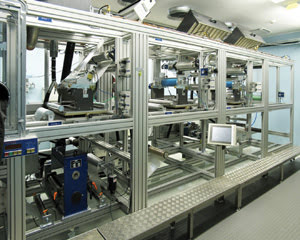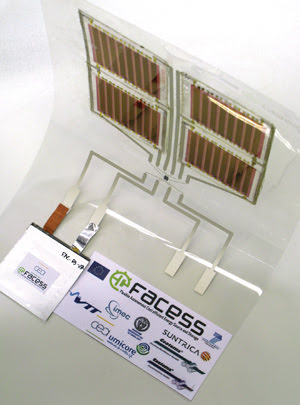Dr. Jukka Hast, Dr. Kimmo Solehmainen and Marja Vilkman, VTT Technical Research Centre of Finland
To pave the way for commercialization of printed electronics and
optics applications, two European Union-funded projects are developing roll-to-roll-based
fabrication technologies.
In the first project, called FACESS (Flexible Autonomous Cost
efficient Energy Source and Storage), roll-to-roll printed organic photovoltaics
and energy storage devices are being developed. In the second one, Polaric (Printed,
Organic and Large-Area Realisation of Integrated Circuits), the aim is to bring
the performance of printed electronics to a new level by combining roll-to-roll
compatible high-resolution steps in the transistor fabrication process, and to demonstrate
the developed high-performance organic electronics in various consumer applications.
Traditionally, the primary function of printing has been the delivery
of data and information for visual inspection and further interpretation by humans
or machines. Nowadays, printing and other large-area R2R (roll-to-roll)-compatible
processes enable cost-efficient mass manufacturing of electronics and other functionalities
on large-area and flexible substrates such as plastic, paper and fabrics. Figure
1 shows one of the pilot machines for printed electronics at VTT Technical Research
Centre of Finland.

Figure 1. Shown is a pilot printing machine for printed electronics.
Images courtesy of VTT Technical Research Centre of Finland, Printed Functional
Solutions.
New printable-functional materials, print-production processes
and reading mechanisms are expanding the role and function of printing toward novel
application fields. This is the opportunity gap between traditional paper, packaging
and printing industry products, and ICT/ electronics industry products, and it can
realize completely new types of applications and businesses; e.g., disposable sensors,
simple “electronic” components and circuits, large-area functional paperlike
intelligent products, smart packages, tag-and-code technology-based ICT and hybrid
media services.
The market potential loaded to printed and organic electronics
is extremely high. Several independent market analysts expect it to become a $250
billion to $300 billion market within 20 years. All electronic applications require
power, a challenge that will be emphasized in printed electronics applications,
where power sources also must be implemented on flexible form.
In the FACESS project, energy harvesting and storage are being
tackled. The goal of the project partners – VTT Technical Research Centre
and Suntrica Oy, both of Finland; Interuniversity Micro-Electronics Centre of Belgium;
Commissariat à l’Energie Atomique of France; Politechnika Warszawska
of Poland; Umicore SA of Belgium; and Coatema Coating Machinery GmbH and Coatema
Maschinenbau GmbH, both of Germany – is to develop cost-efficient R2R production
techniques for organic solar cell modules and rechargeable lithium batteries.
Also in development is an application-specific integrated circuit
(ASIC) chip that would optimize and control the battery charge from the organic
solar modules. To be flexible, the chip is thinned to 30 μm and interconnected
on the flexible backplane. The plan is to use R2R-compatible production technologies
to manufacture an energy storage foil of four printed organic solar cell modules
comprising a 100-cm2 area, a printed battery and an interconnected ASIC to control
the charge operation. Under AM1.5, a reference organic solar cell module can produce
250 mW of power to charge the battery. The battery size is approximately 30 cm2
and its capacity, between 1 and 3 mAh/cm2.
In Figure 2, four gravure-printed organic solar cell modules operate
at 2.3 percent photon-conversion efficiency at air mass 1.5 illumination on a 15.5-cm2
area per module. The modules are manufactured using commercially available conductive
– and photoactive – polymers. The rechargeable lithium battery has anode
and cathode electrodes screen-printed on aluminum and copper foils, and an assembled
commercial separator foil. The battery produces ~40-mAh capacity. The 30-μm-thick
ASIC is flip-chip-bonded using anisotropically conducting adhesive on the backplane
substrate.

Figure 2. This energy storage foil is from the FACESS project.
All other components of the energy source built for the FACESS
project are printed, except for the electronic part. This is because the performance
limitations of printed electronic circuits force the use of traditional, silicon-based
microchips for the control electronics. To enable wholly printed devices, the printed
circuits must be improved significantly.
In response to this challenge, the partners launched POLARIC earlier
this year. The new project is expected to lead to smaller transistor dimensions,
with the aim of improving their performance and demonstrating their use in applications
including printed radio frequency identification tags and active matrix displays.
The work is divided among the coordinator, VTT Technical Research
Centre of Finland; AMO GmbH, 3D-Micromac AG, Fraunhofer-Gesellschaft IZM and micro
resist technology GmbH, all of Germany; BASF, CSEM SA and Asulab, a division of
The Swatch Group Research and Development Ltd., all of Switzerland; Cardiff University
and Imperial College London, both of the UK; IMEC of Belgium; Joanneum Research
Forschungsgesellschaft mbH of Austria; and Obducat Technologies AB of Sweden.
Figure 3 demonstrates state-of-the-art organic electronics (printed
and lithographically prepared) and compares it to the performance required for operationally
good enough organic circuits; i.e., the POLARIC target. In detail, the high performance
of the organic circuits referred to means high speed (kilohertz to megahertz), low
operating voltage (±<5 V), low power consumption and low parasitic capacitance.
The POLARIC target of improved performance is indeed challenging. However, that
level of performance is needed to enable substantial market penetration of organic
electronics.

Figure 3. The POLARIC target is compared with the state of the art
in organic electronics. R2R = roll to roll.
Besides improved performance, the manufacturing process of organic
electronics must be suitable for large-scale production. Thus, another, equally
important goal of the project is to develop further R2R printing methods; e.g.,
using R2R-compatible nanoimprinting technologies for short-channel configuration
of the electrodes to produce components and circuits with extremely high yield.
The project also will provide solutions for the fabrication of R2R tools, making
serial replication viable. Finally, the circuit design, modeling and characterization
of organic electronics will be developed to offer a toolbox similar to that of silicon-based
microelectronics. Thus, it is justified to say that the project will revolutionize
the way printed electronic circuits are made by combining large-area fabrication
methods with high-performance organic electronic circuits on a scale not previously
attempted.
After the FACESS and POLARIC projects, high-performing organic
electronic building blocks and manufacturing platforms can be used in all areas
of printed electronics, including sensors, memory, batteries, photovoltaics, lighting
and any combination of these devices. By combining different functionalities and
blocks on the same flexible foil, and integrating the whole process in a cost-efficient
way, the huge market potential for printed electronics and optics will turn into
reality.
Meet the authors
Dr. Jukka Hast is a senior research scientist; e-mail: [email protected].
Dr. Kimmo Solehmainen also is a senior research scientist; e-mail: [email protected].
Marja Vilkman is a research scientist; e-mail: [email protected]. All three work
at VTT Technical Research Centre of Finland, Printed Functional Solutions.